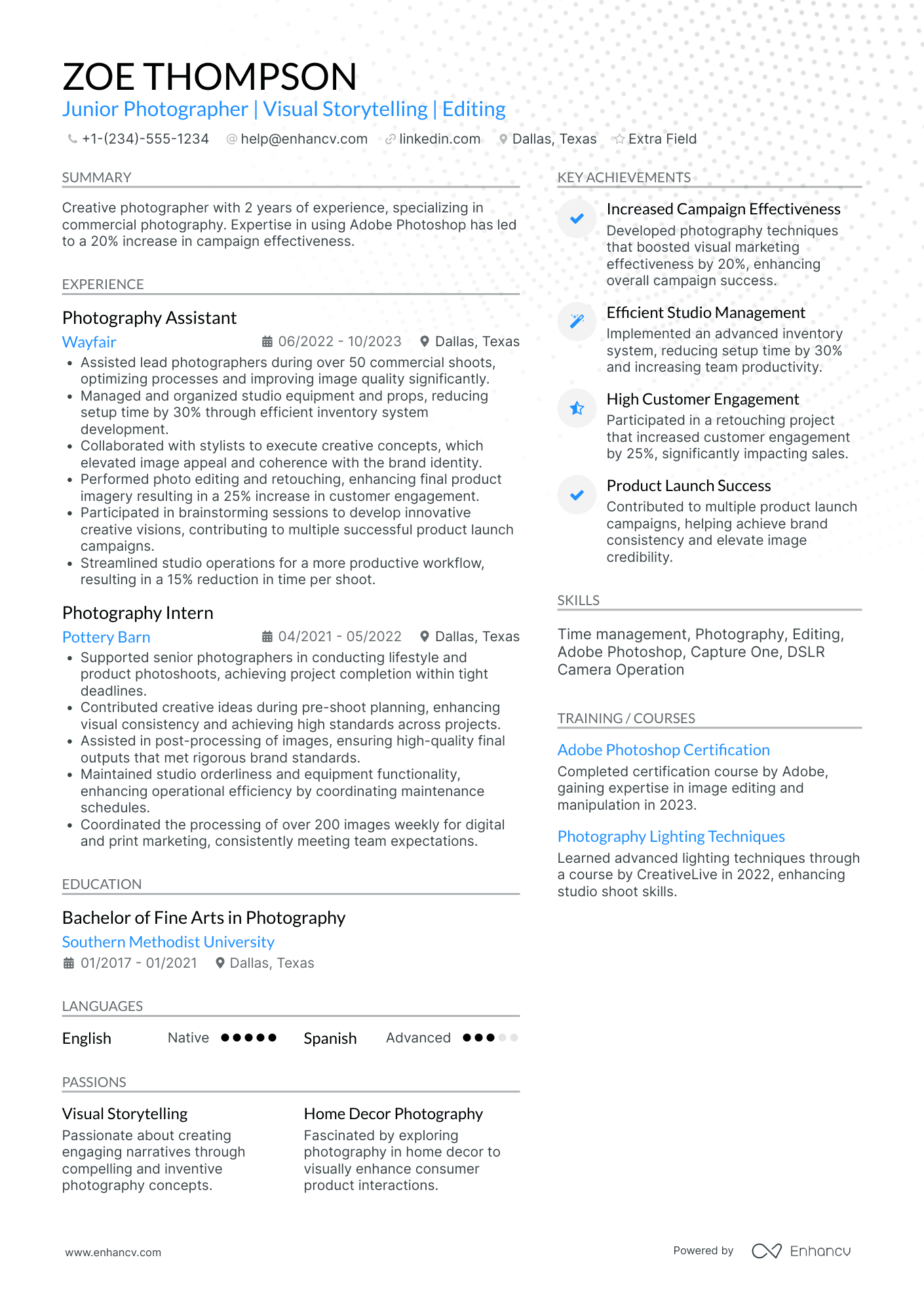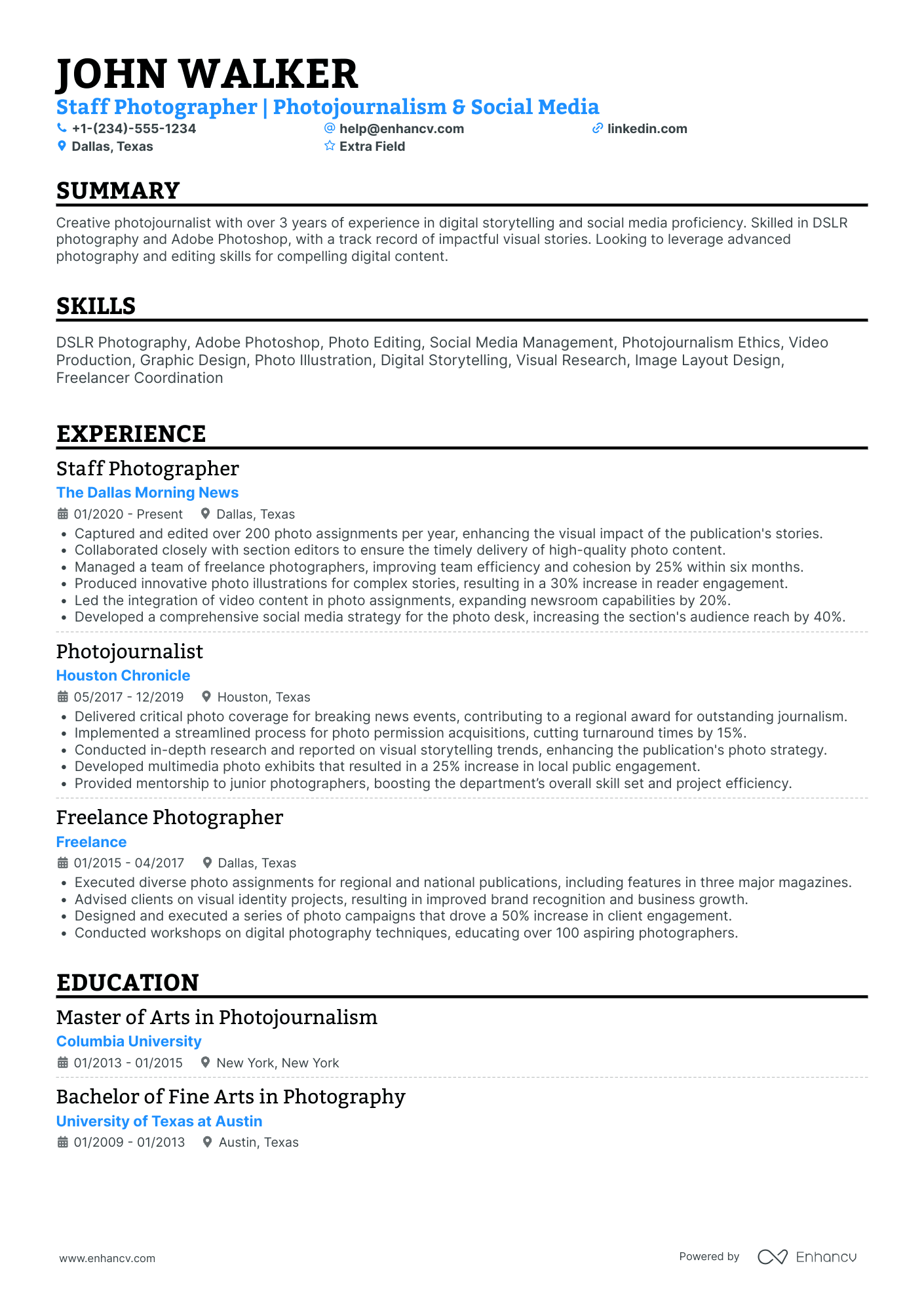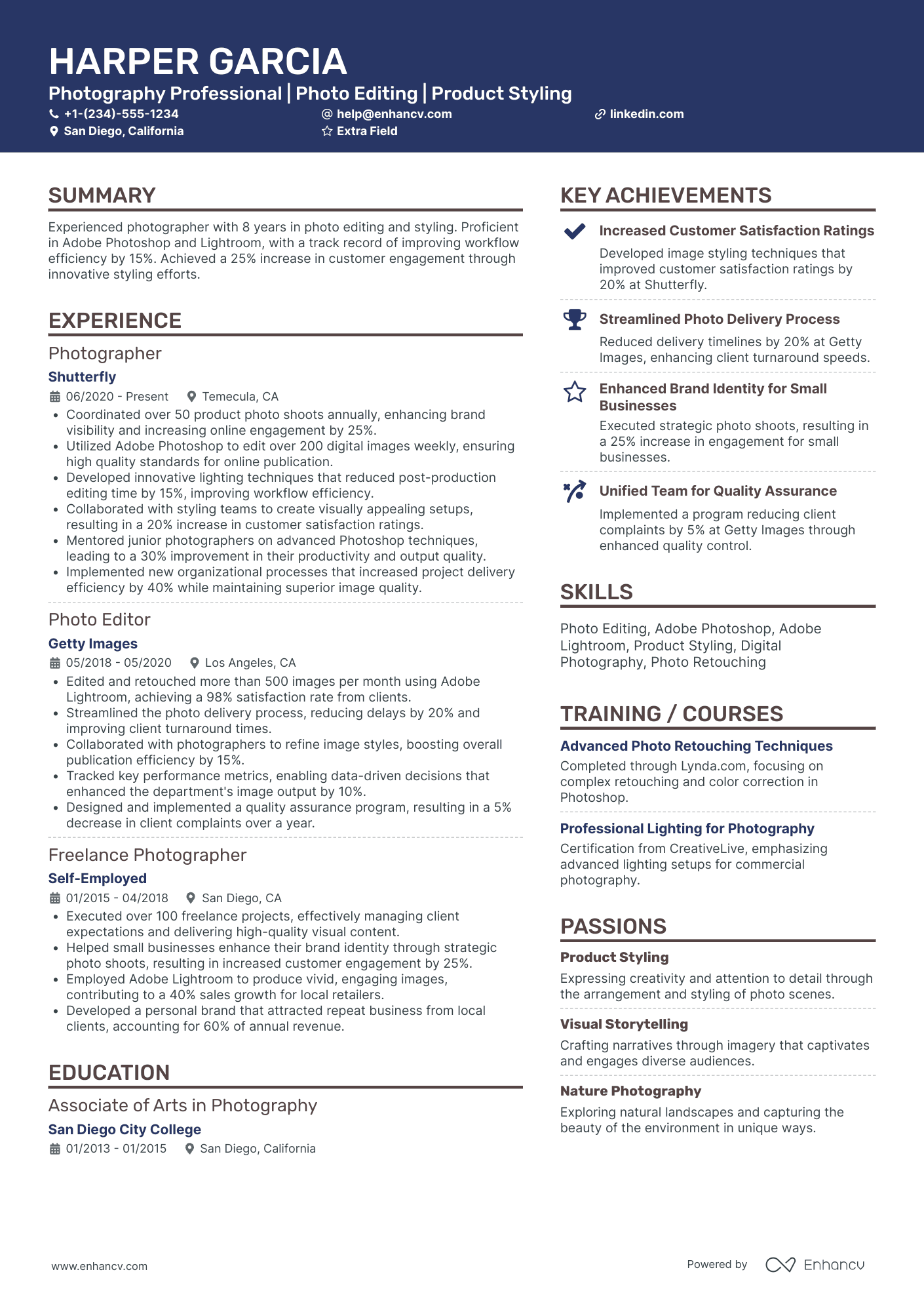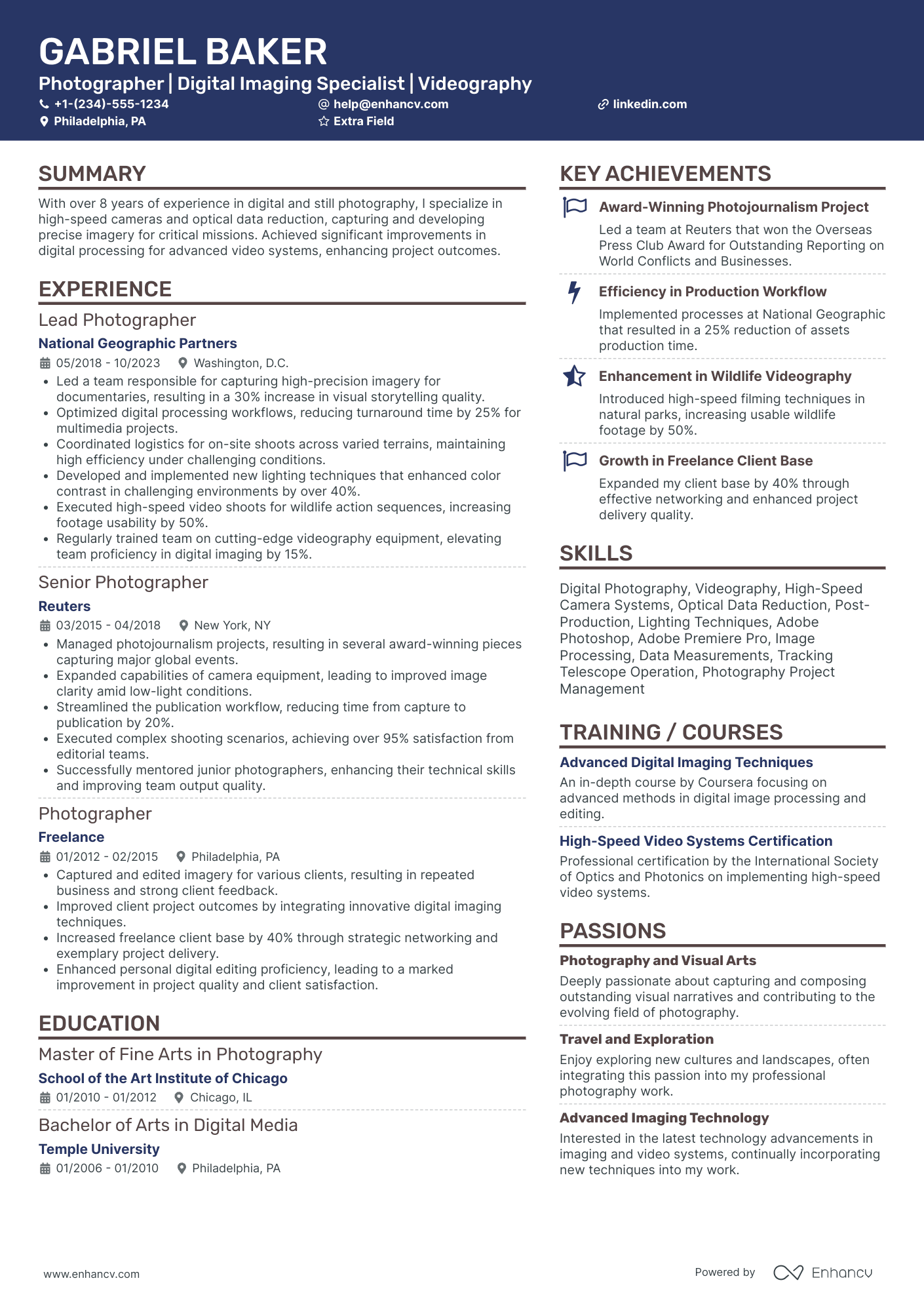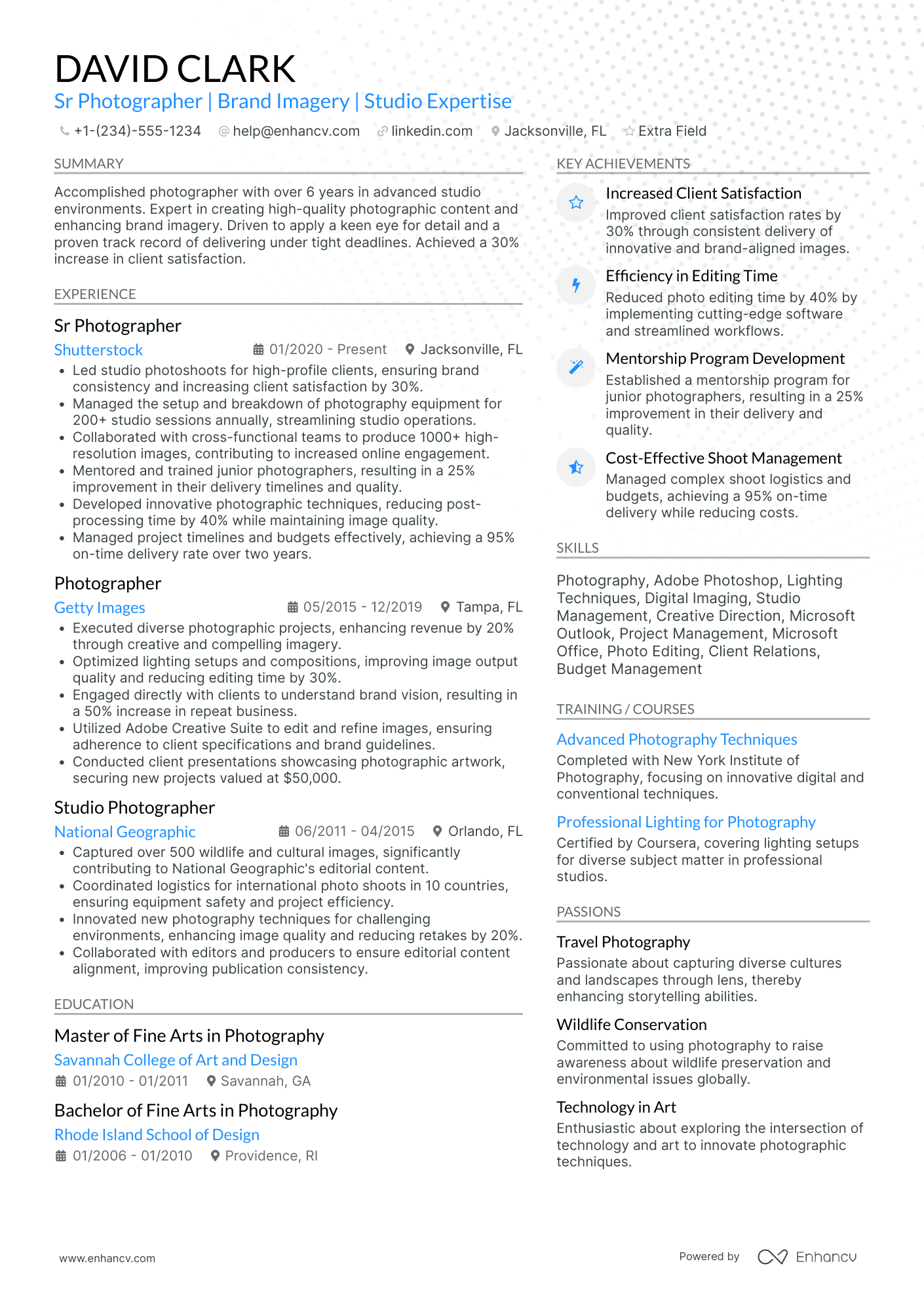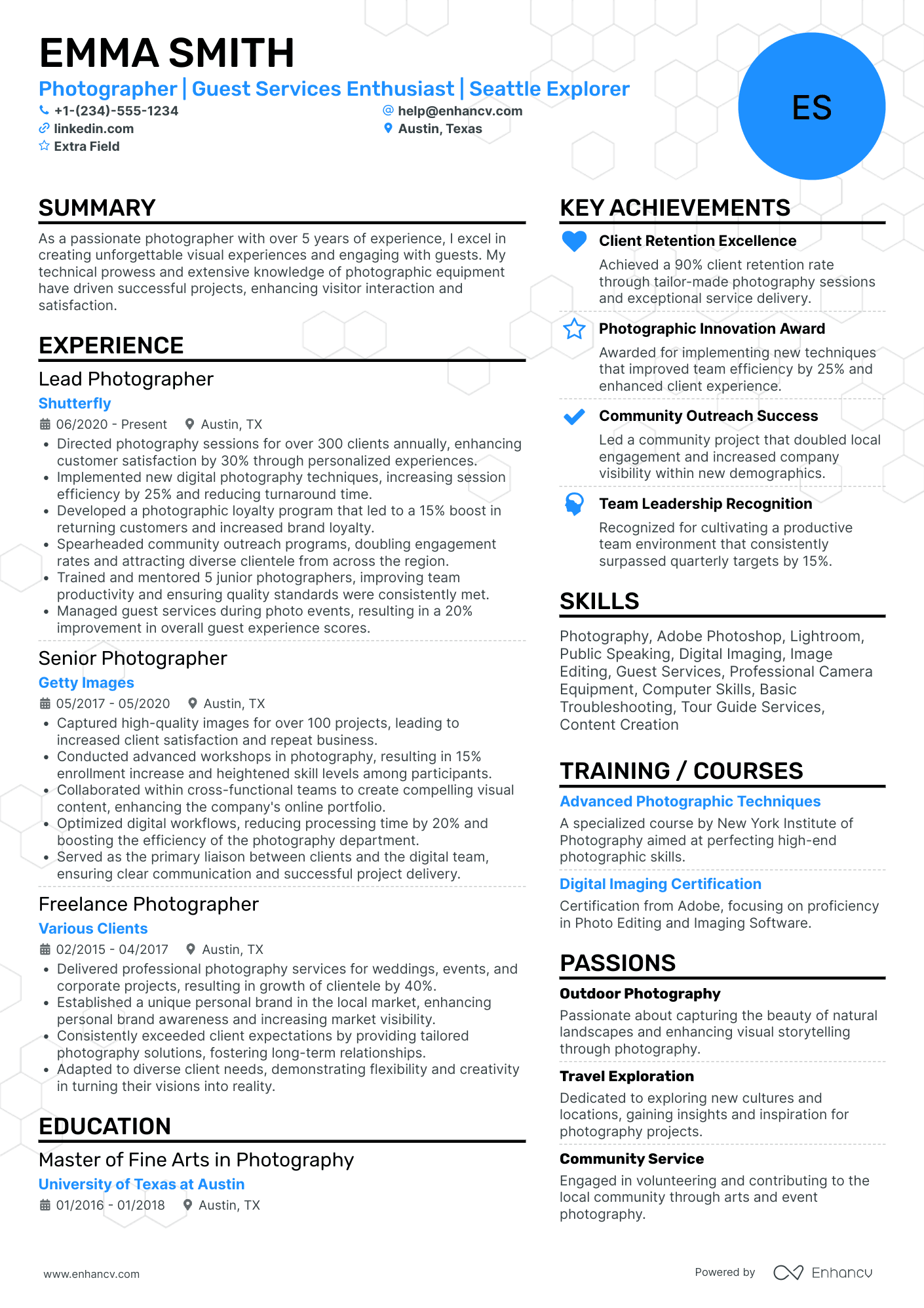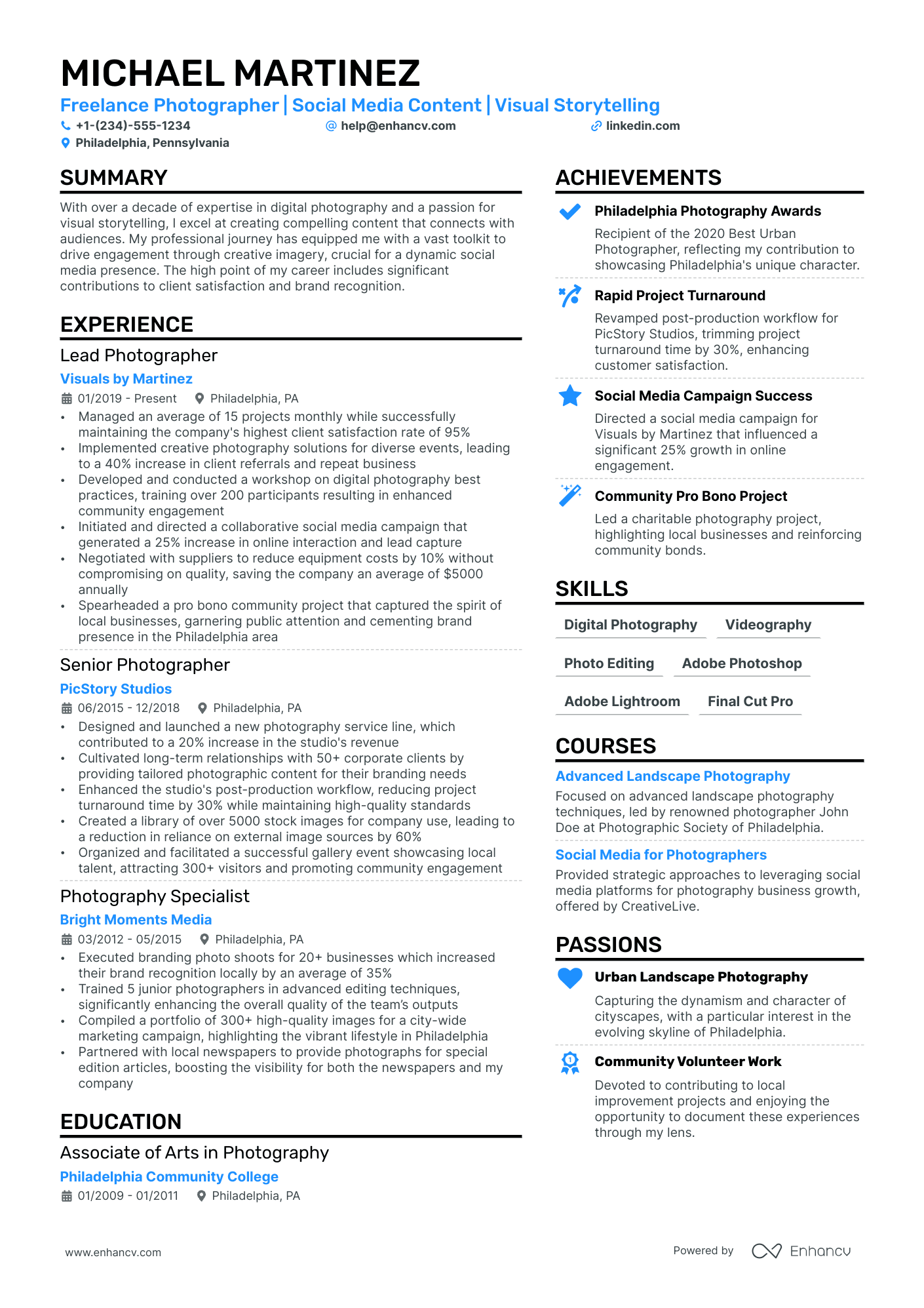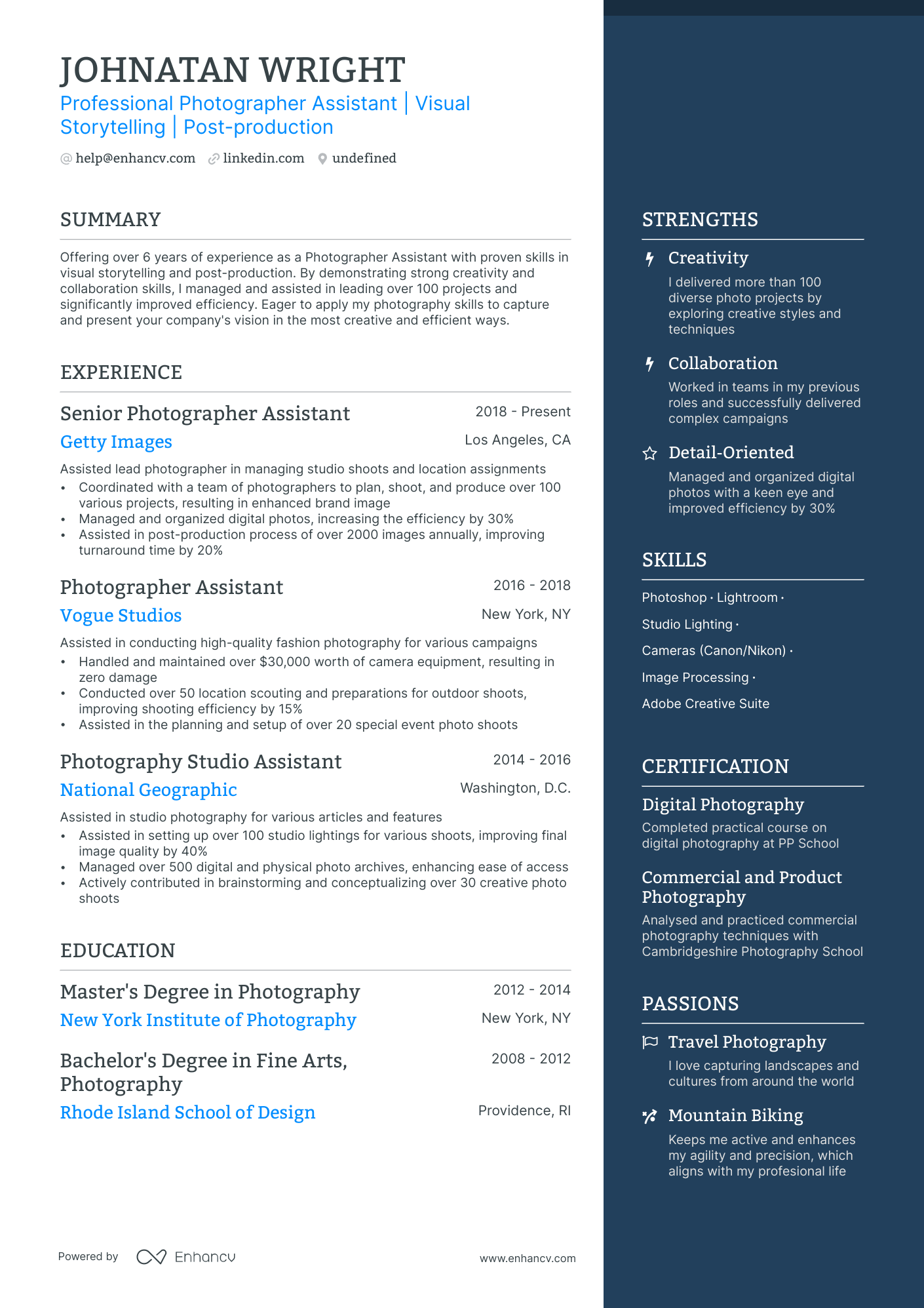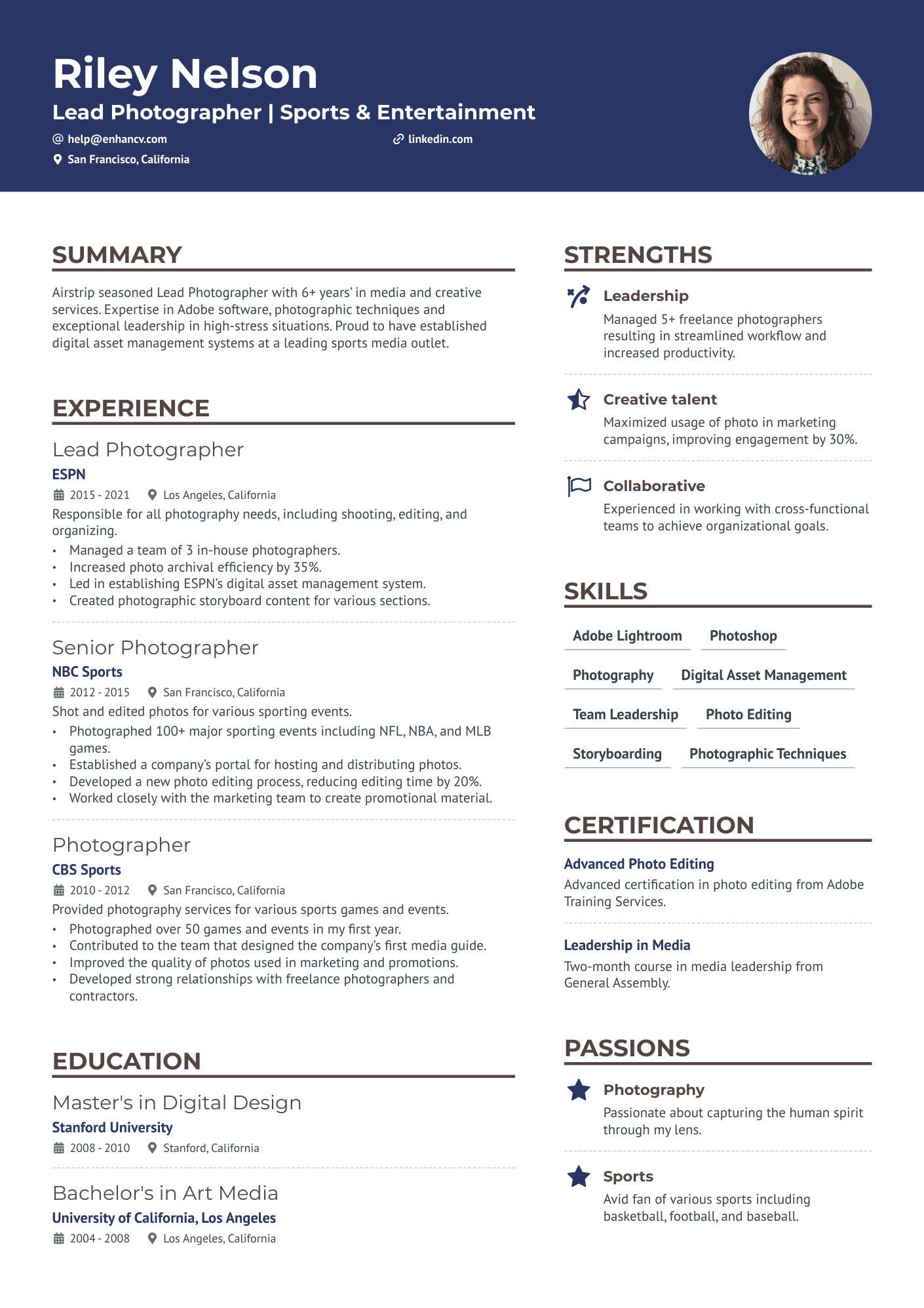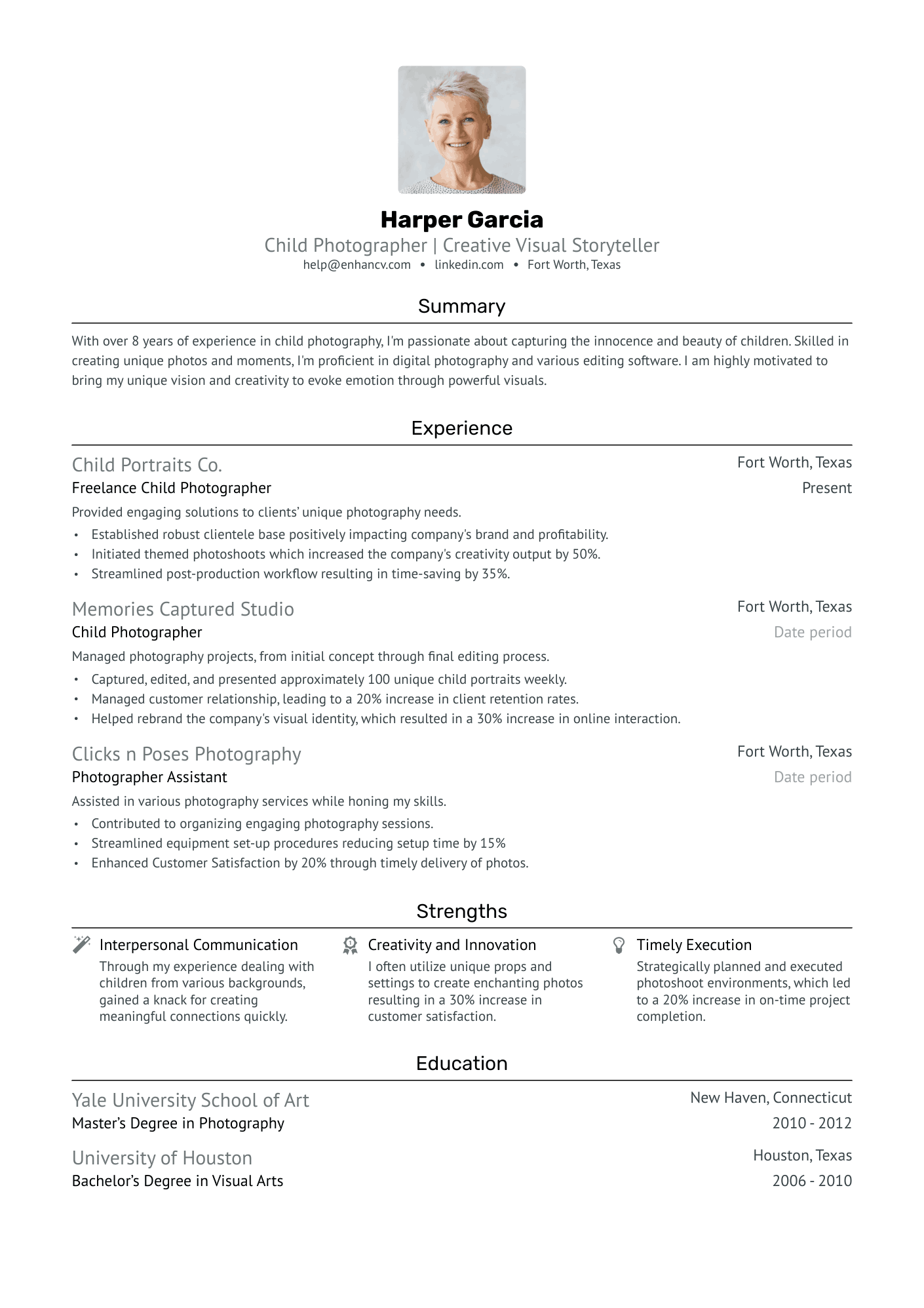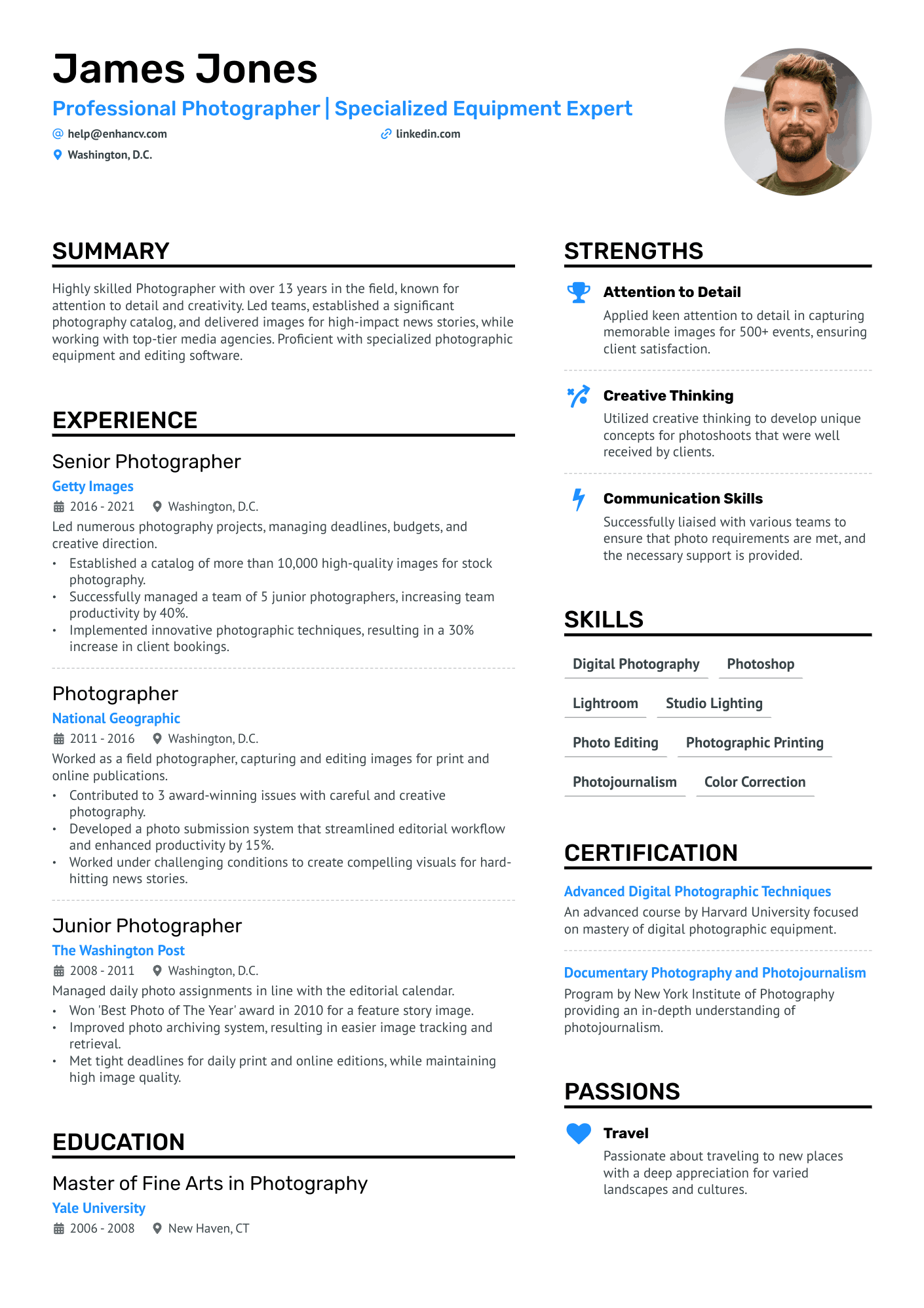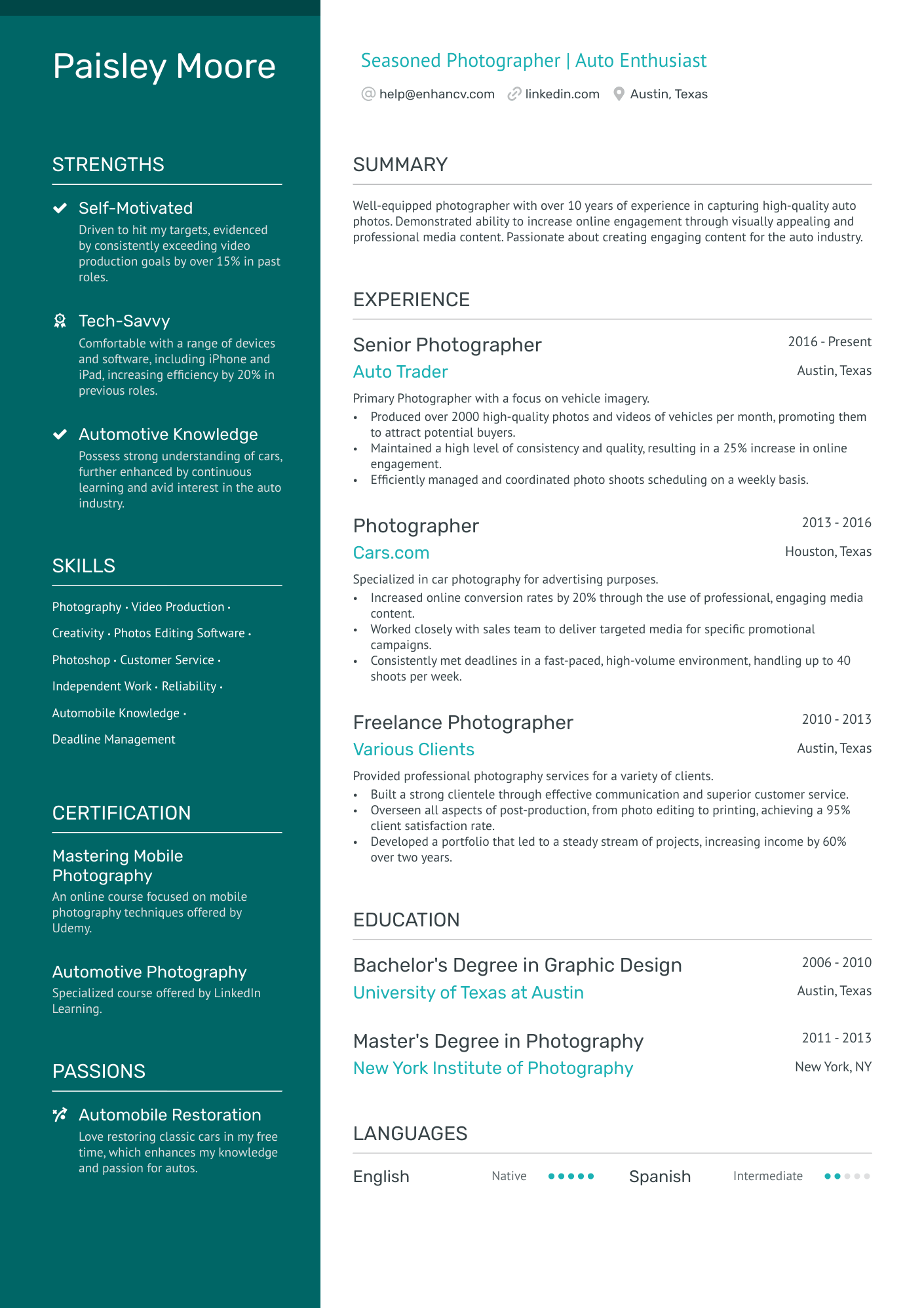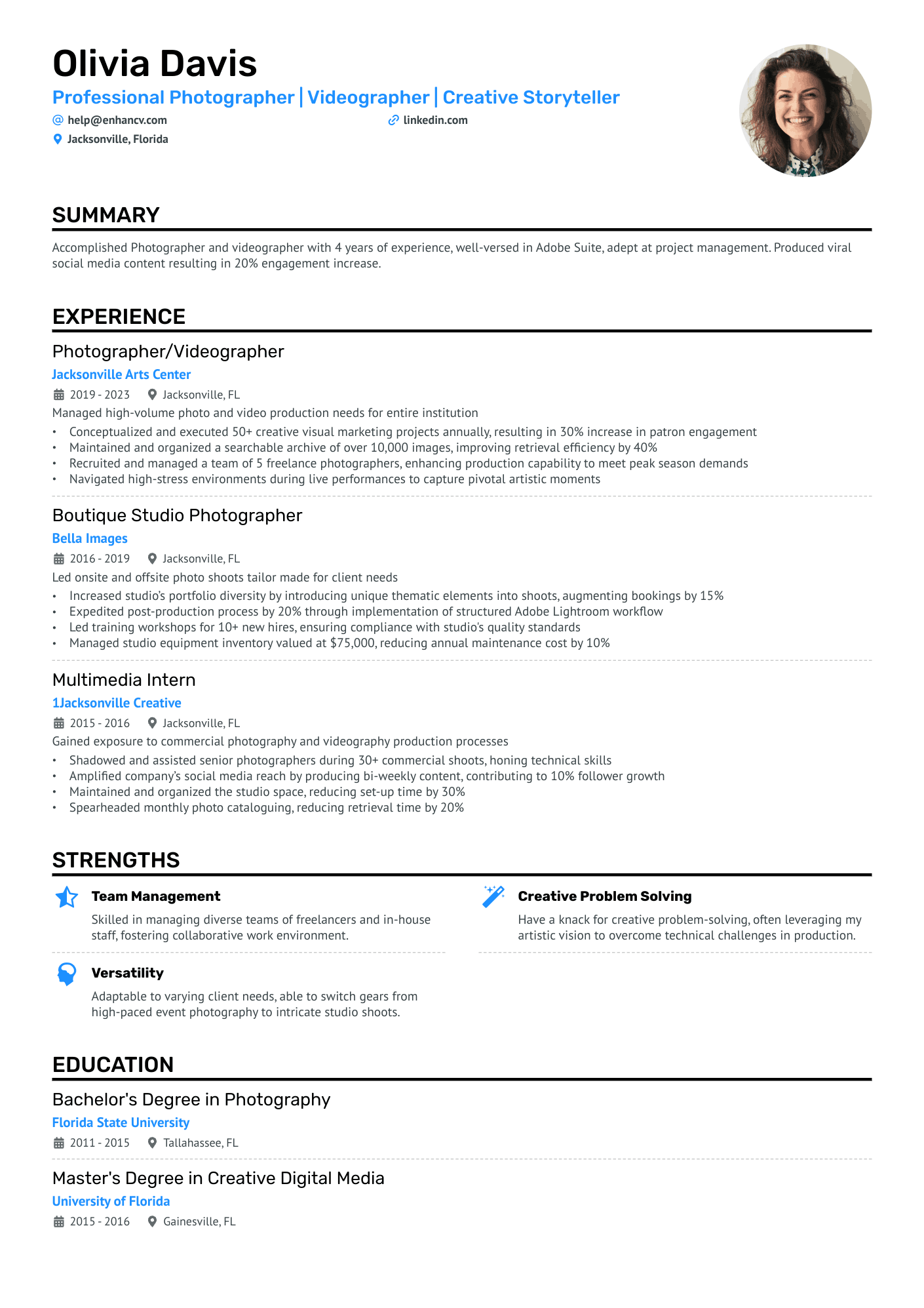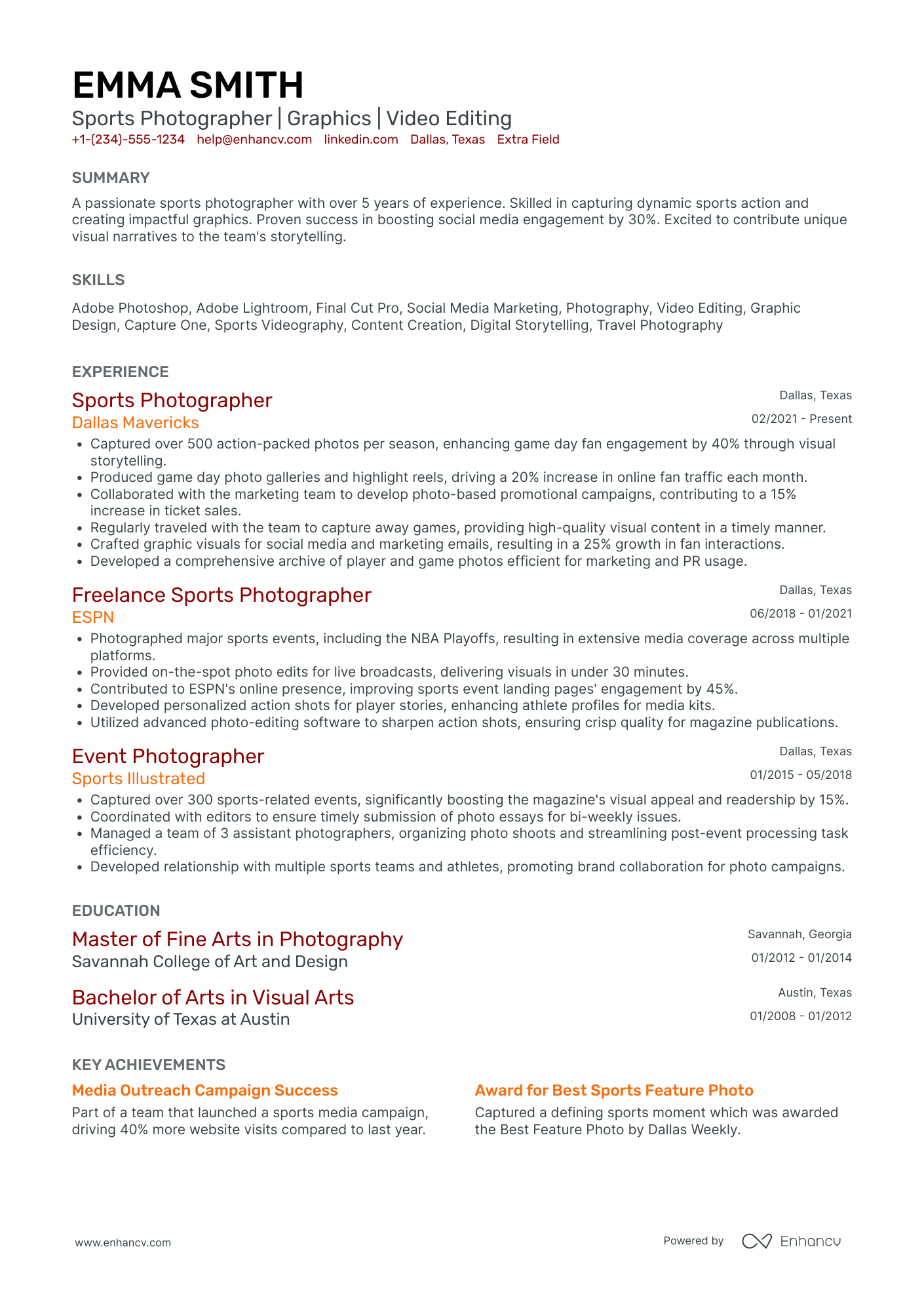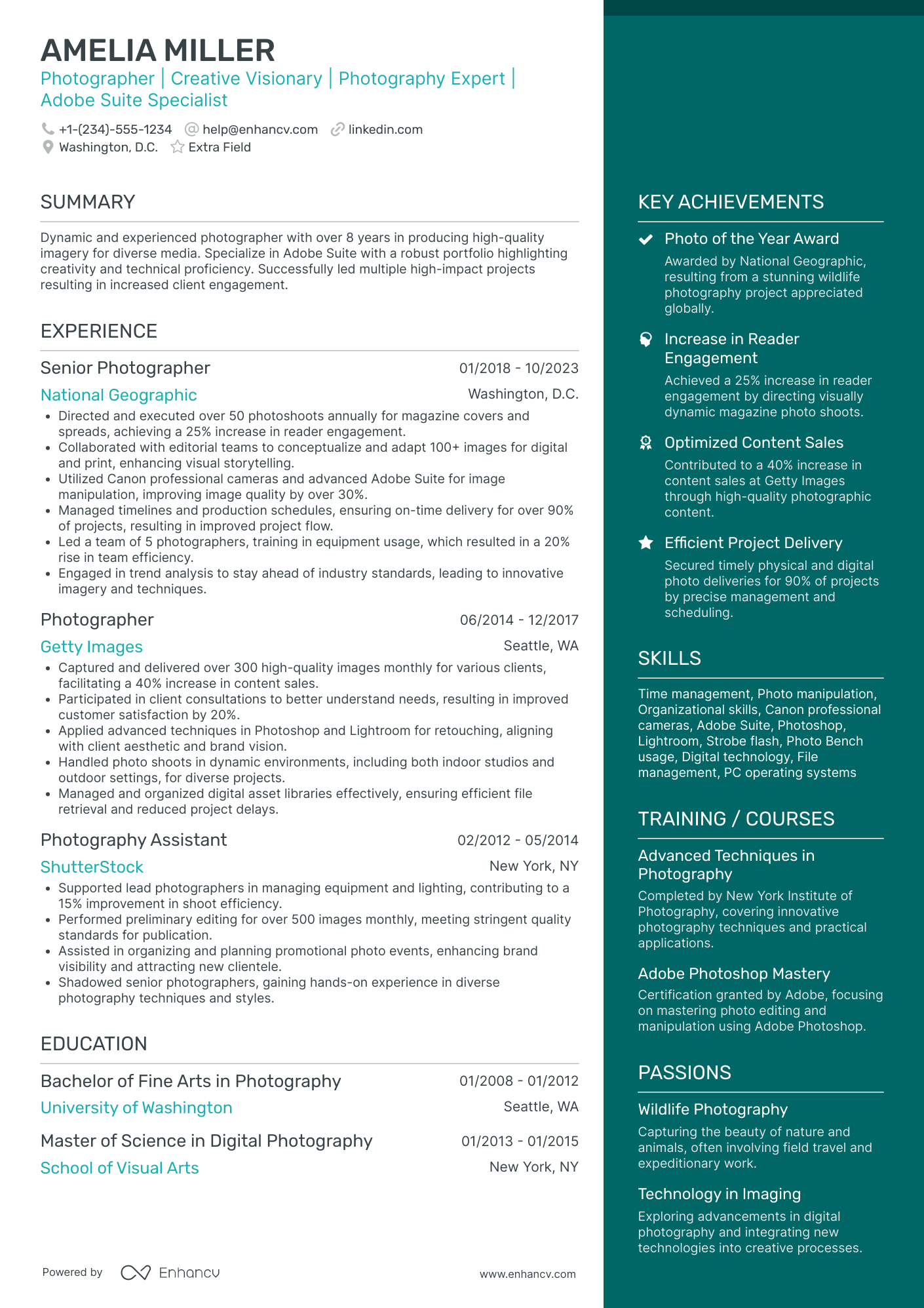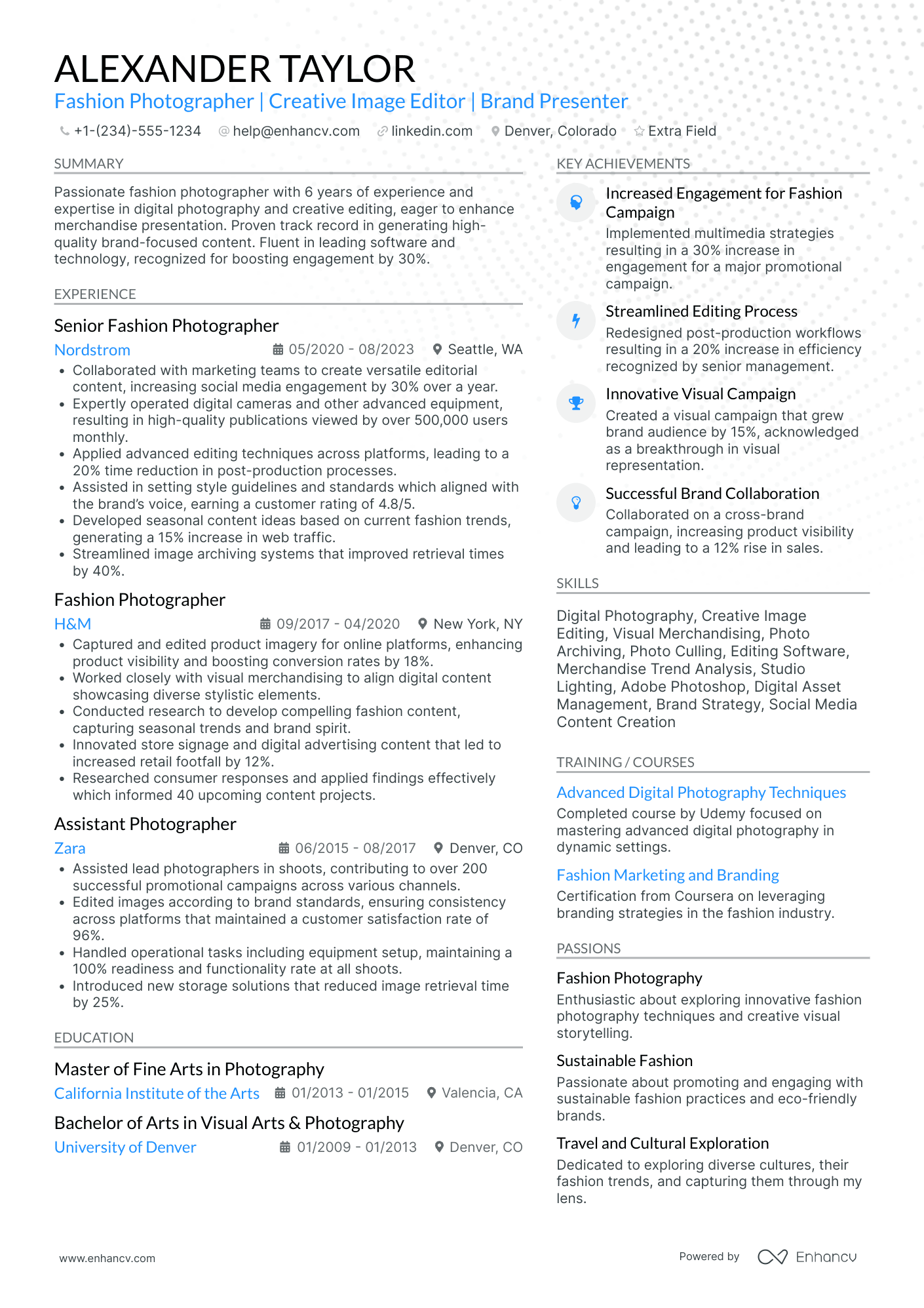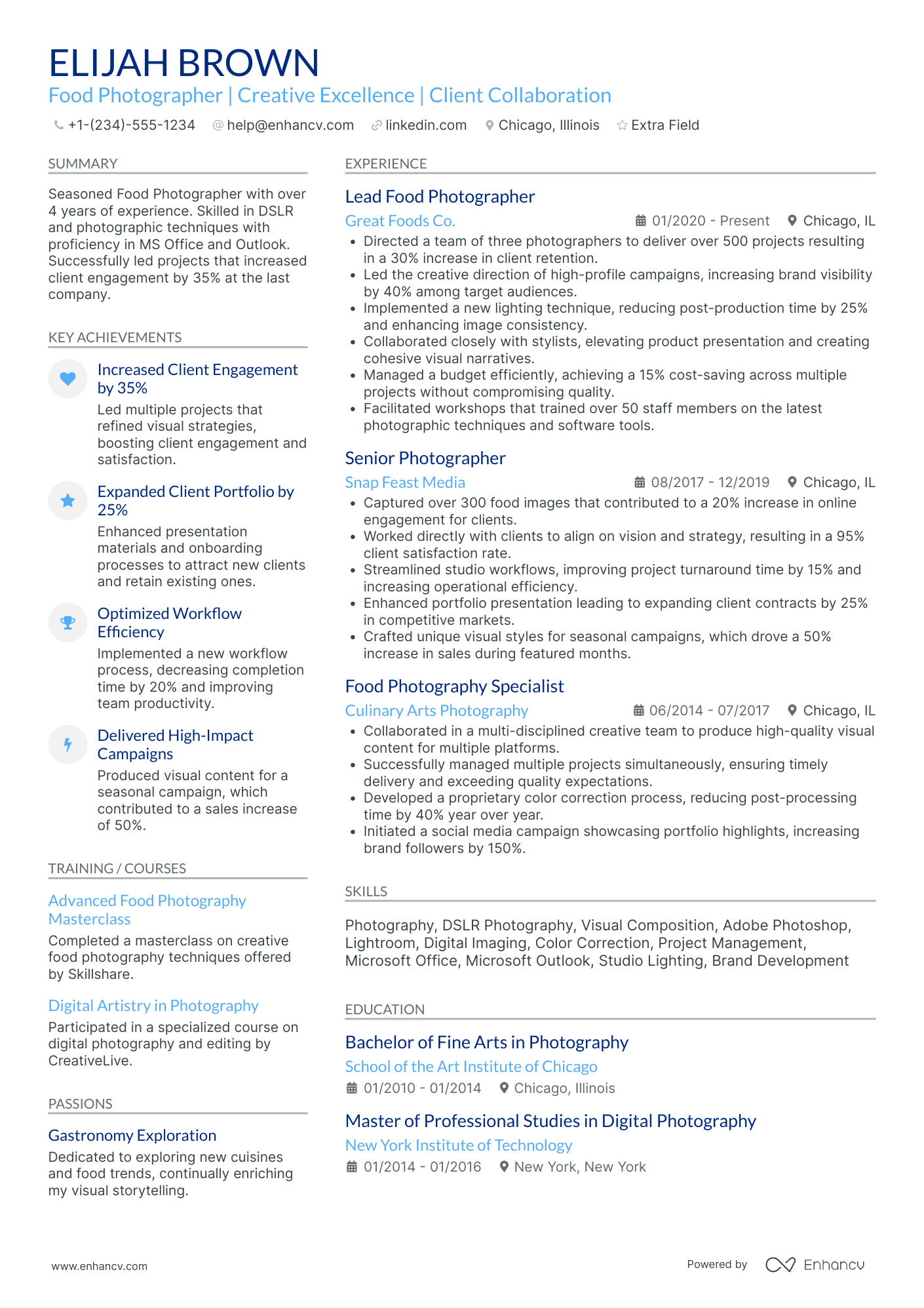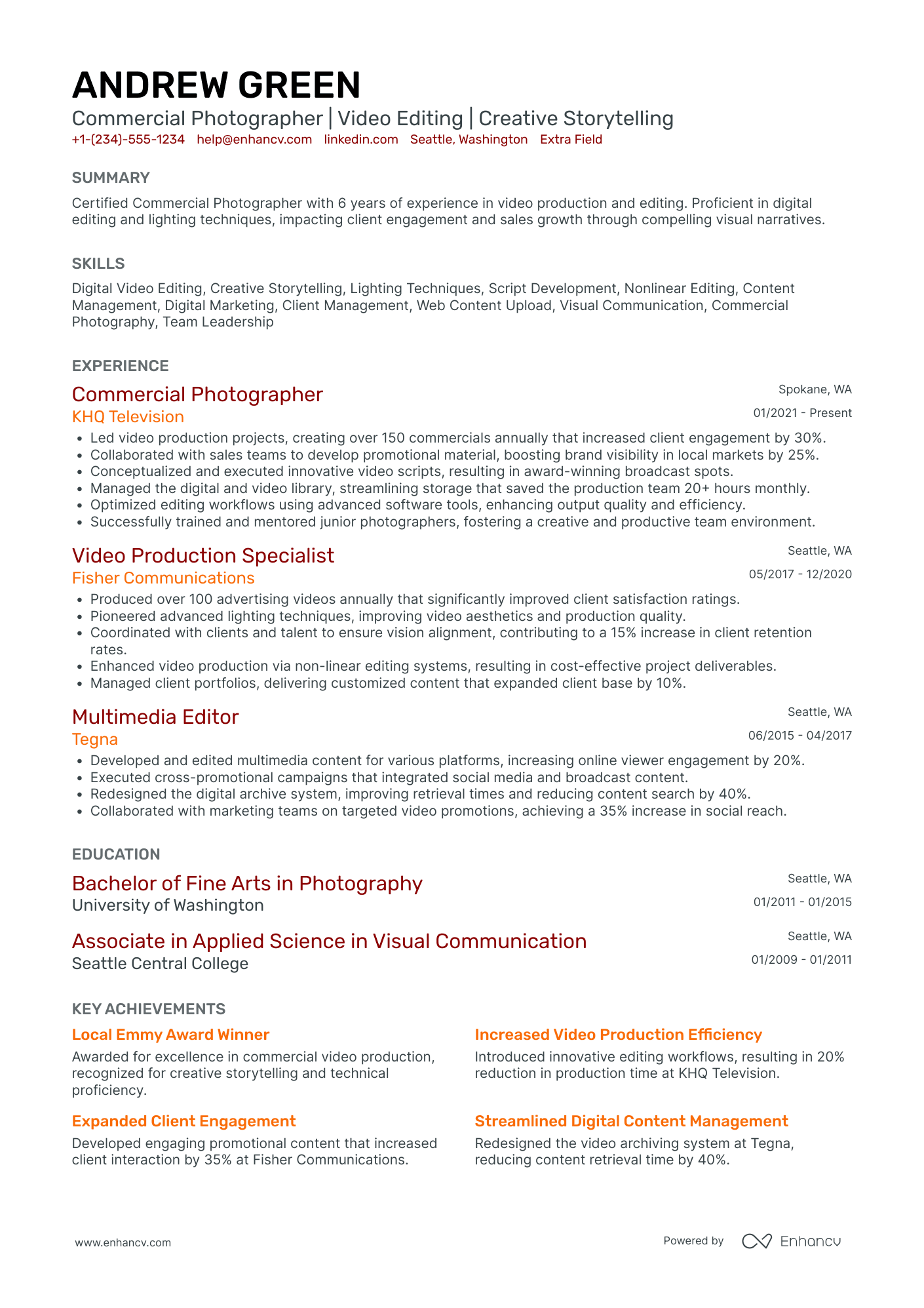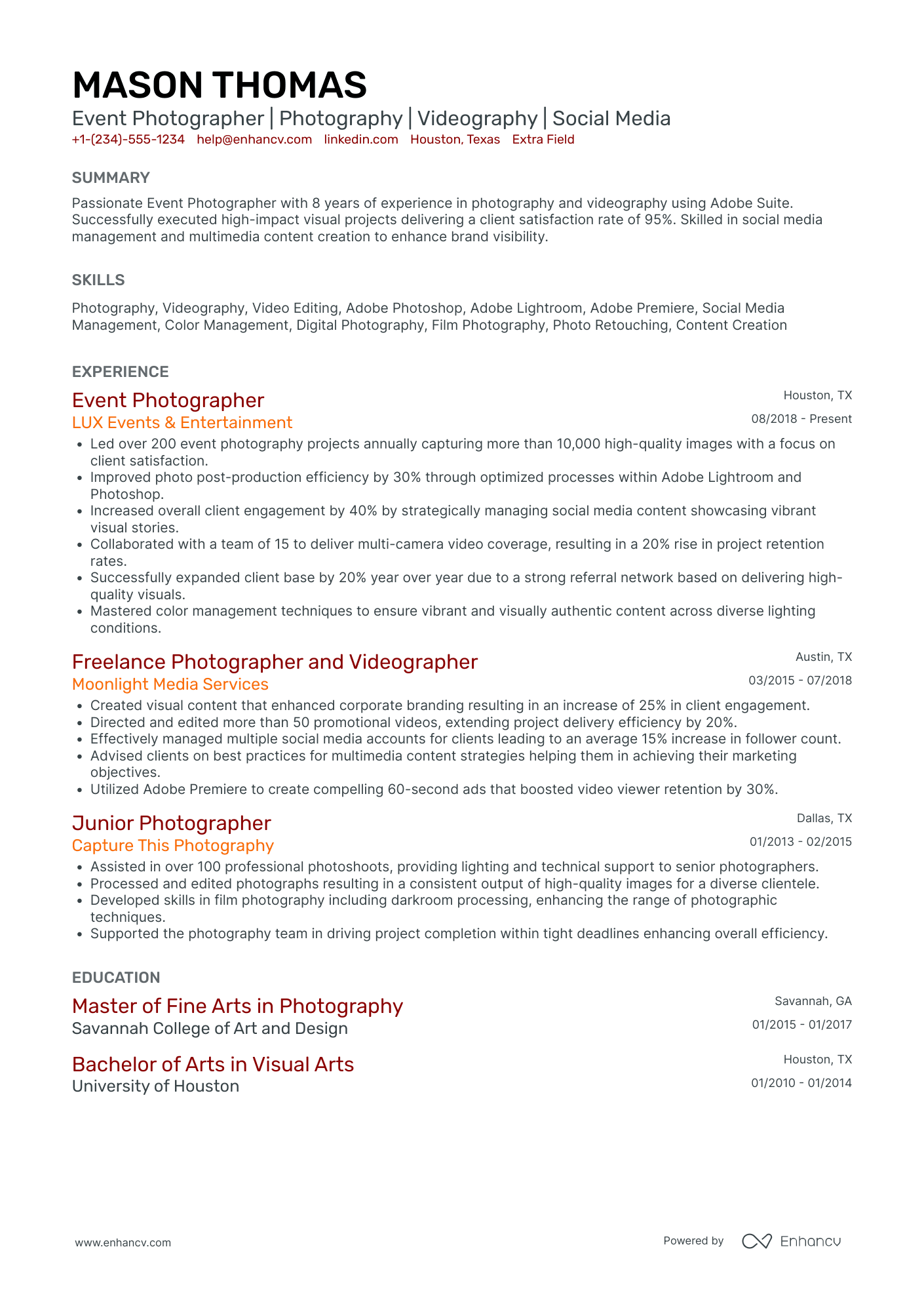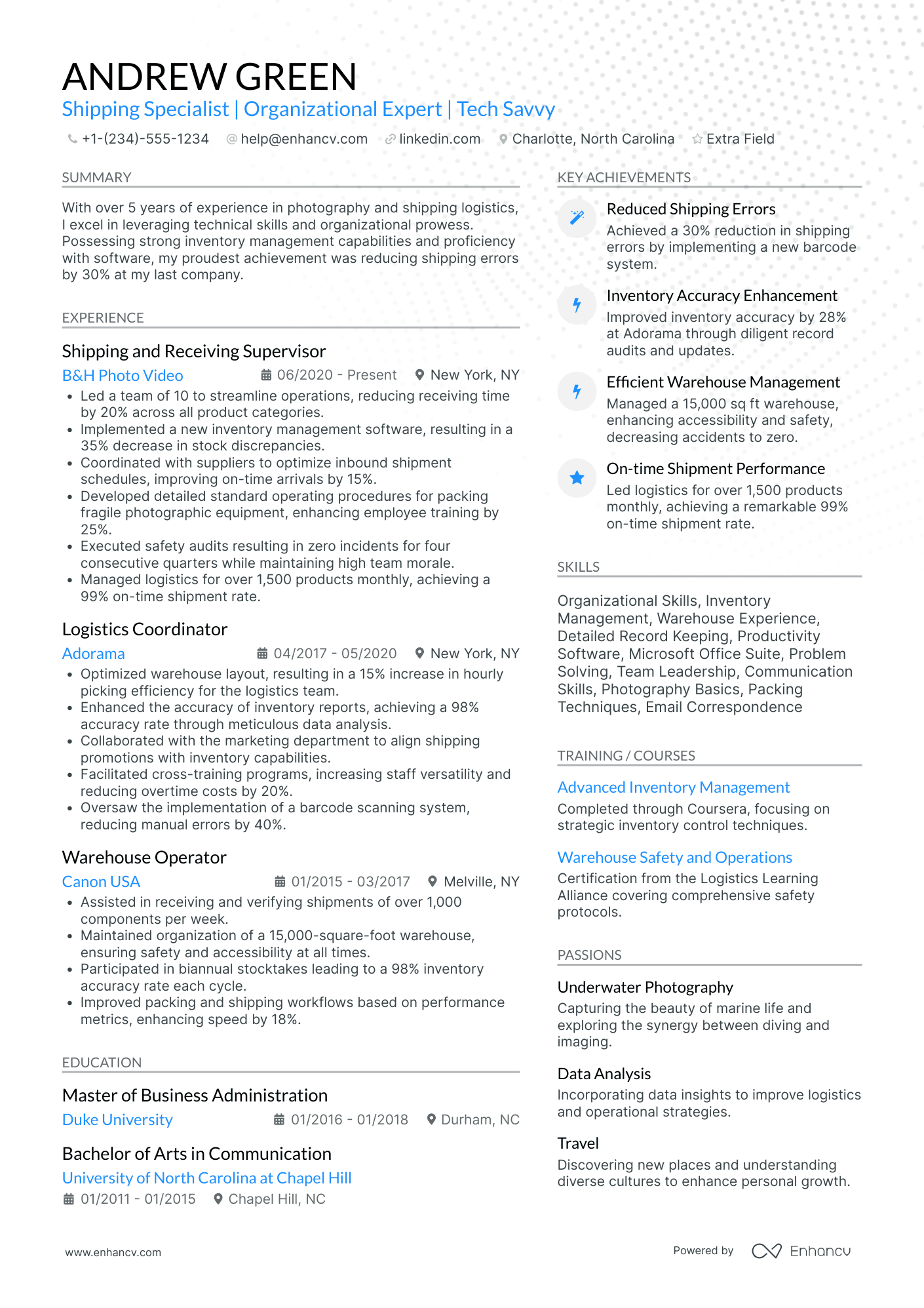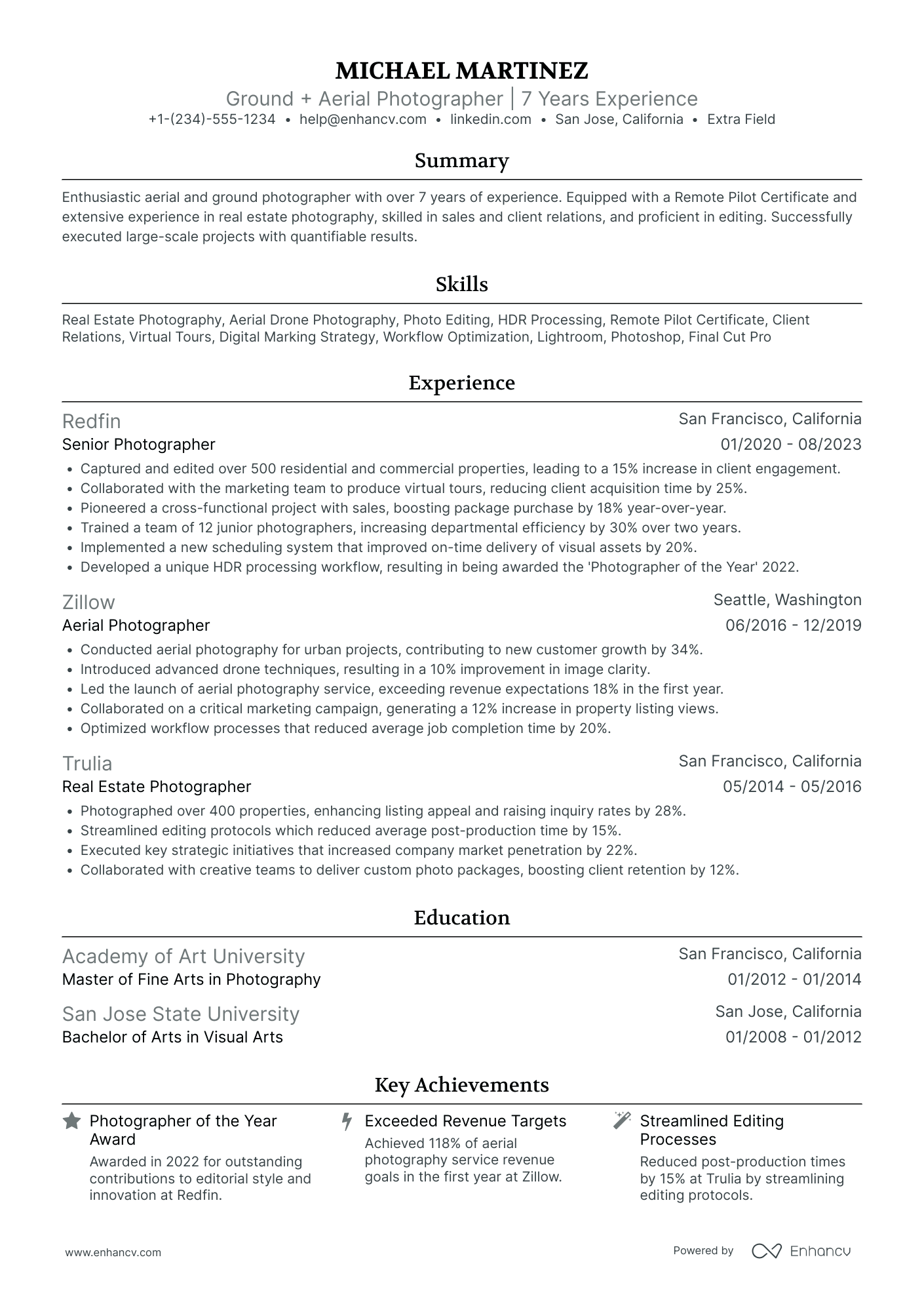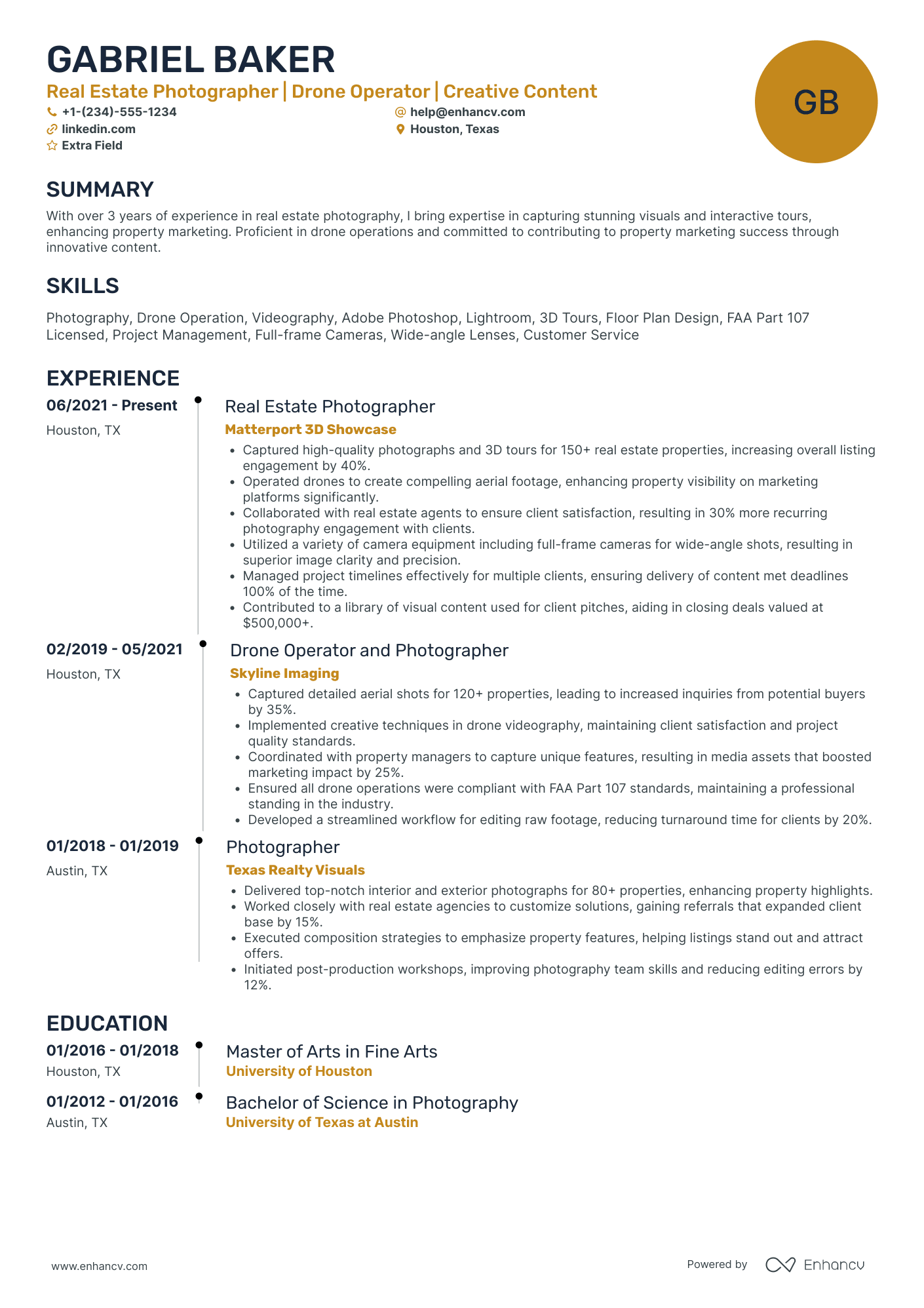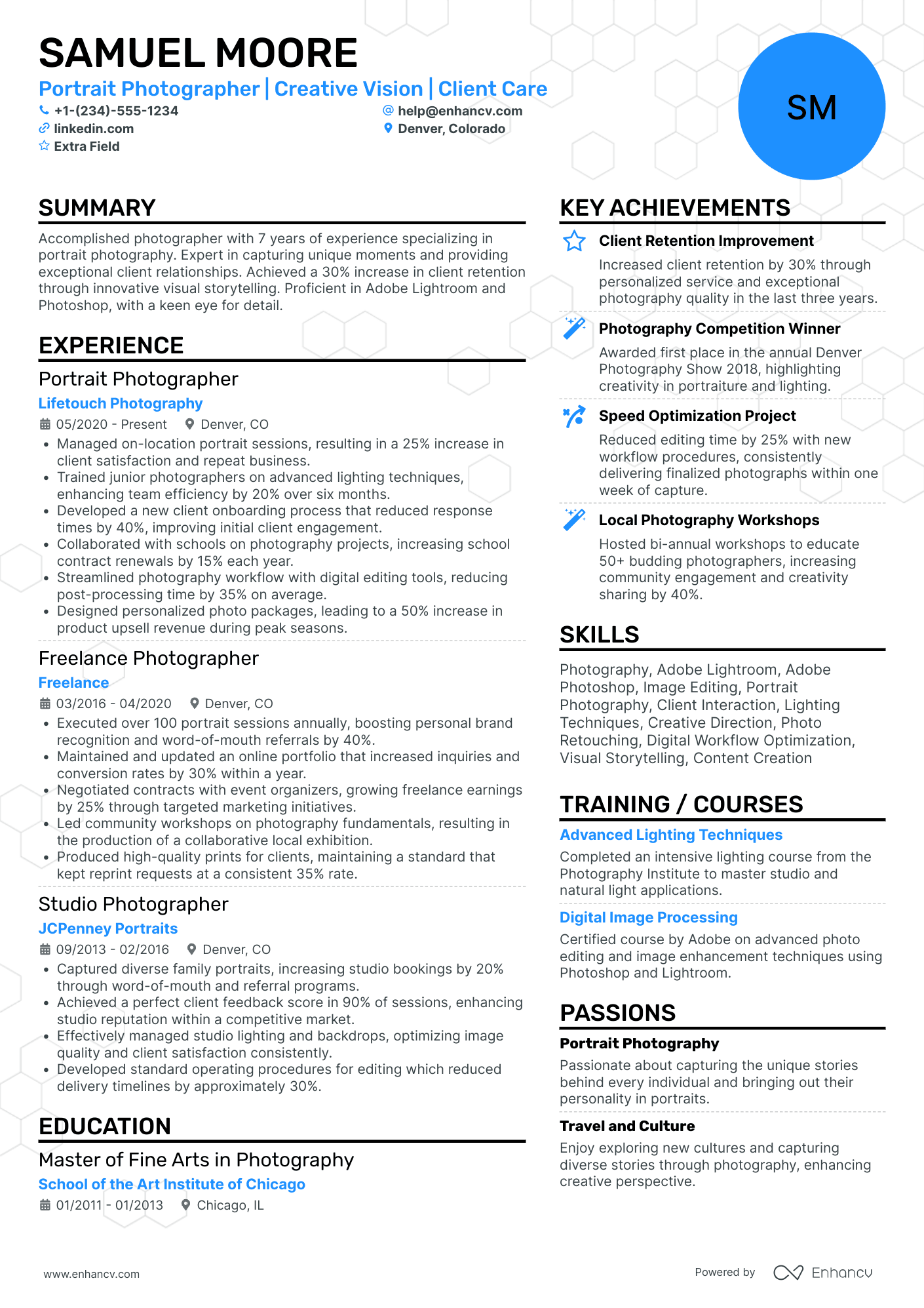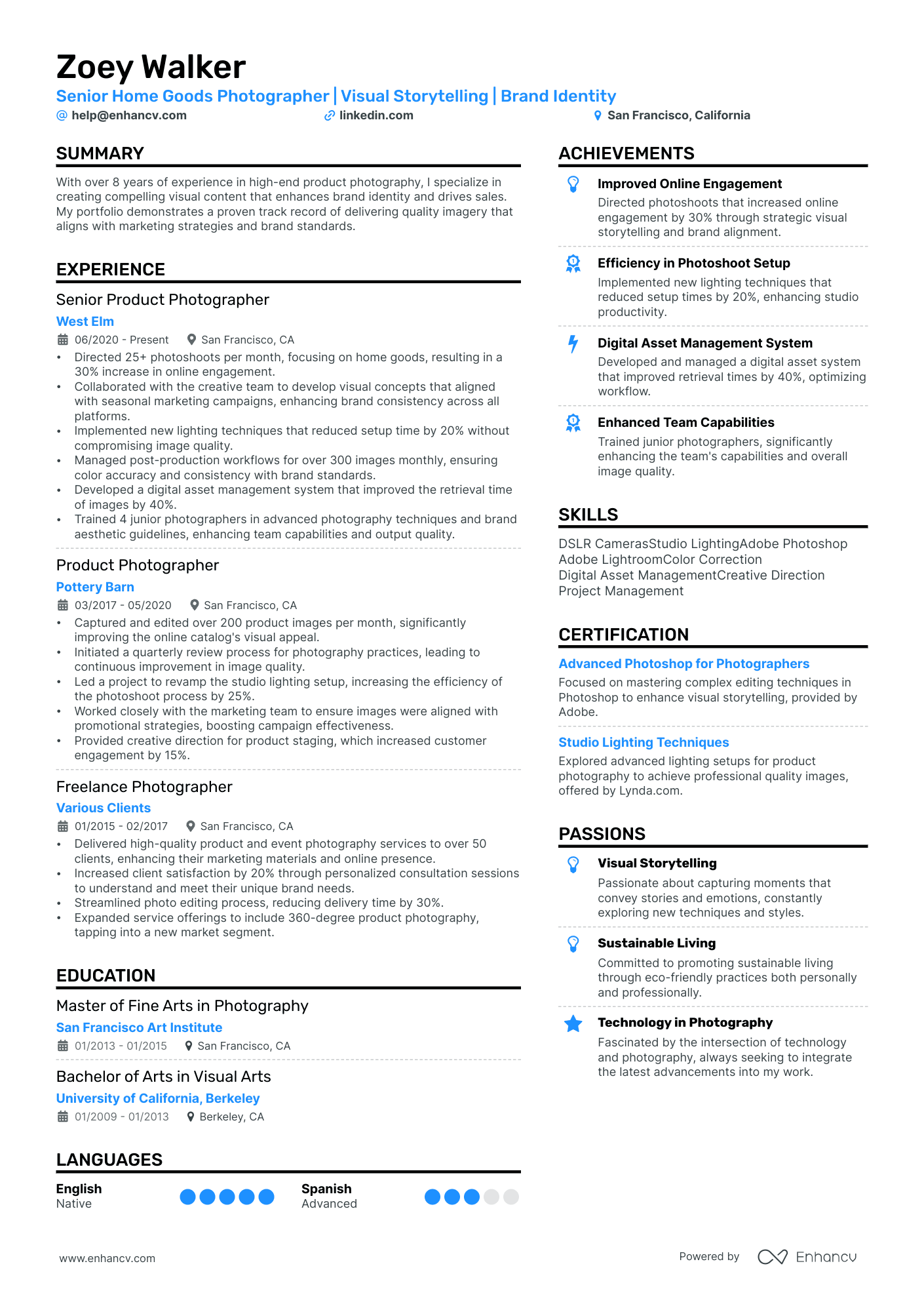Crafting a resume as a photographer means more than listing your skills and experiences; it's an opportunity to showcase your vision and creativity to potential clients or employers. A compelling resume for a photographer not only highlights technical proficiency and artistic achievements but also tells a story of a unique perspective and passion for capturing the moment. Whether you're aiming to freelance, join a studio, or exhibit your work, the right resume can set you apart in the competitive world of photography, opening doors to new opportunities and collaborations.
Creating a photographer resume has its challenges, however. Here are a few things you’ll need to try to overcome:
- Lack of proper certifications: While many photographers are self-taught, certain positions or industries may require specific certifications, qualifications, or degrees in photography. This can be challenging to present if you haven’t got any formal training.
- Communicating artistic vision: Photography is a highly creative field, so it can be challenging to convey one's unique artistic vision and style within the confines of a traditional resume. Here are some creative resume tips.
- Highlighting experience across different photography genres: photographers working in multiple genres (e.g., wedding, portrait, commercial, nature) face challenges in concisely presenting this range in a resume.
This guide will give you the tools to embrace these obstacles (as well as many others) and overcome them successfully. Let’s begin!
Here are a few other resume guides related to the field of photography that may be of interest to you:
- Photographer Assistant Resume
- Cinematographer Resume
- Videographer Resume
- Artist Resume
- Journalist Resume
- Filmmaker Resume
Photographer resume example
Let’s start with an excellent example of a photographer’s resume to give you a better understanding of what we’re aiming for.
Here’s what this applicant does well in their resume:
- Quantifiable achievements: The resume effectively uses quantifiable achievements (e.g., "resulting in a 30% increase in online engagement") that clearly demonstrate the impact of their work.
- Skills and software proficiency: It lists relevant skills and software proficiencies that match the job description, ensuring they appear well-equipped for the role.
- Visual storytelling and brand identity: The title and summary emphasize strengths in visual storytelling and brand identity, aligning with the job’s focus on creating compelling visual content.
Now, into the details of making a picture-perfect resume.
How to format a photographer resume
A resume format is an essential element to consider and choosing the right one can make all the difference. When formatting a photographer's resume, the focus should be on visually communicating your expertise, creativity, and professional experience. Here are some universally accepted tips to ensure your resume stands out:
- Choose a clean layout: Opt for a simple, elegant design that allows your content to shine without distracting graphics. Keep the layout professional, and readable, maintaining a resume length of no more than a page or two long (not including your portfolio).
- Highlight your portfolio: Your portfolio is your strongest asset. Include a link to your online portfolio at the top of your resume, near your contact information.
- Professional experience: Use a reverse-chronological resume to list your experience, starting with the most recent. Detail your role, the company or client, and the dates of your engagement. For each position, include bullet points that highlight key projects, your contributions, and any notable achievements or recognitions.
- Specialize your skills section: Beyond general photography skills, highlight specialized techniques (e.g., aerial photography, underwater photography), proficiency with specific equipment, or expertise in photo editing software.
- Education and certifications: Include formal education, workshops, and certifications relevant to photography. This section can help you stand out, especially if you have credentials in specialized areas of photography.
- Customize for the job: Tailor your resume for each application based on the job description. Highlight experiences and skills that match the job's requirements using keywords.
- Use professional language: Maintain a professional tone throughout your resume. Use action verbs to describe your responsibilities and achievements.
- Proofread: Ensure there are no typos or grammatical errors. These mistakes can detract from your professionalism.
- PDF format and fonts: Many people ask if they should format their resume in PDF or Word - the answer is to always submit it in PDF. It preserves the layout and design across different devices and platforms. Also, choose the right resume font - Rubik, Lato, Montserrat, Raleway, Exo 2, Volkhov, serif and sans-serif fonts are the best.
- ATS compatibility: Applicant tracking system (ATS) software scans resumes and cover letters to weed out applicants based on factors set by the employer. This can include resume keywords, design and resume layout, length, and salary requirements. If your resume doesn’t make the cut, you won’t be asked for an interview.
A few more tips:
- Standard formatting is critical because ATS may not correctly parse or may completely overlook important information in resumes with non-standard layouts, graphics, or unconventional section titles.
Align your resume with the market’s standards – Canadian resumes may have unique layout guidelines.
Is your resume good enough?
Drop your resume here or choose a file. PDF & DOCX only. Max 2MB file size.
- You may come up against portfolio challenges. If the job application platform doesn't support direct links, include a clear invitation to request a portfolio or visit your LinkedIn profile where the link can be featured.
- Also, remember to embrace your diverse experience. Many photographers have varied experience across several genres, so best to focus on versatility and adaptability in your summary. Tailor the rest of your resume to align more closely with the specific job's requirements.
The top sections on a photographer's resume
- Contact information: This allows prospective employers to get in touch for interviews or further discussions - pretty important.
- Objective statement: Tailored for a photography role, it should give an overview of your career goals and outline why you are the right fit for the position.
- Skills and qualifications: This section lets recruiters assess what technical abilities you have and how aligned they are with the job requirements.
- Portfolio: Crucial for any photographer’s resume, this component visually demonstrates your style, creativity, and experience in photography. It gives the hiring party concrete examples of your work.
- Work experience: This section includes details about your previous photography roles or related experiences to show how you've applied your skills in practical scenarios and your career progression.
What recruiters want to see on your resume
- Technical skills: photographers need to understand how to use camera equipment, lighting, and editing software. Recruiters want to ensure you have the necessary skills to perform the job.
- Creative eye: This is a crucial element for a photographer. Recruiters look for individuals who can capture unique angles and perspectives to create stunning visuals.
- Experience: Depending on the role's seniority, recruiters may prioritize applicants with significant industry experience, as this demonstrates the ability to handle the job's responsibilities.
- Portfolio: This gives a direct look at the applicant's ability and style. Recruiters take this into account to check if the candidate can deliver the desired results.
- Physical stamina and flexibility: This is important for photographers who need to carry heavy equipment, work in challenging conditions, or adapt to rapidly changing environments. This can be used to gauge your readiness for the job's physical demands.
So, we’ve gone over some preferred resume formats and which sections you’re going to want to include. Next, let’s look at each part individually.
How to impress with your photographer resume experience
The best way to present your work experience on a photographer's resume is by clearly articulating your technical skills, creative accomplishments, and professional experience. It needs to be in a manner that is both comprehensive and easy to understand for potential employers or clients. Here’s how you can effectively structure your photographer experience:
Job title, company name, location, and dates of employment doing so in reverse-chronological order: Start with the basics to give a clear timeline of your professional journey.
Senior Photographer
Studio X, New York, NY,
Jan 2016 - Present
Responsibilities and duties: Briefly describe your key responsibilities in each role to provide context about your day-to-day activities.
- Led a team of photographers, coordinated photoshoots, and managed post-production processes.
Achievements and contributions: Highlight your achievements, such as successful projects, exhibitions, publications, or any accolades. Use quantifiable results to demonstrate your impact.
- Increased client satisfaction by 30% through innovative shooting techniques and timely delivery of edited images.
Technical and creative skills: Mention specific technical skills, software proficiency, and creative competencies related to photography.
- Proficient in Adobe Photoshop and Lightroom, skilled in portrait and landscape photography, with a strong eye for lighting and composition.
Here’s a wrong and a right way of an experience entry:
- •Did photography stuff for many clients.
- •Took photos and edited them.
Why this is bad:
- Vagueness: Lacks specific details about role, location, and timeframe, making it difficult to gauge the level of experience or professionalism.
- Generic descriptions: Uses vague language ("did photography stuff") that fails to convey the scope of work, specialties, or achievements. Best to list at least three bullet points here.
- Lack of impact: Does not mention any achievements, client growth, or any metrics that could demonstrate success or expertise.
- •Specialize in editorial and commercial photography, with work featured in Vogue and GQ.
- •Manage all aspects of photo shoots, including scheduling, styling, and post-processing, resulting in a 40% client base increase year over year.
- •Lead photography workshops focused on portrait and landscape photography, enhancing client understanding and appreciation of photographic art.
Why this is good:
- Specificity: It clearly states the role, employment status, location, and dates, providing a clear timeline.
- Achievements: Highlights notable accomplishments and client base growth, showing impact and progression.
- Skills and responsibilities: Describes the range of skills from technical to educational, showcasing versatility.
How to quantify impact on your resume
- Number of photos taken for a large campaign: This displays the volume of work you can handle and your capability to manage big projects.
- Increase in social media engagement or followers due to your photographs: This showcases your contribution to online growth and digital marketing.
- Specific budget managed for a photography project: This shows your ability to effectively manage resources and demonstrates your responsibility.
- Timeframes adhered to for completing assignments: Punctuality and meeting deadlines are valued in any business setting, and this shows your reliability.
- Number of repeat clients or contracts: This indicates customer satisfaction and the quality of your work.
- Ratio of project bids won: A high success ratio portrays your competitiveness and the market's recognition of your skills.
- Quantity of images sold (if working freelance): This can indicate direct profitability from your work and the market's demand for your style.
- Number of photography exhibitions participated in or organized: Participation in and organizing events indicates your industry involvement and shows your initiative.
How to write a photographer resume with no experience
It can be a scary thing to apply for a new job in an area you have never done before professionally. However, there is a way to do it right and increase your chances of being brought on. Crafting a resume with no experience to show is quite similar across all industries and positions.
Instead of focusing on your work experience, you focus on all the other things. This involves things like highlighting your skills, education, passion for photography, and any relevant projects or informal experiences that demonstrate your talents.
Here's how you can structure such a resume:
- Contact information (header)
- Objective or summary: Write a brief statement that conveys your enthusiasm. Emphasize your commitment to learning and growing as a professional photographer.
- Education: If you have any formal education related to photography or art, list it here. Highlight coursework relevant to photography skills, such as digital imaging, photo editing, or visual arts.
- Skills: Include a photography skills section.
- Projects/Portfolio: Since you lack professional experience, this section is crucial. Describe any photography projects you've completed. These can be personal projects, assignments from courses, or volunteer photography work. Be specific about what you did, the concept or theme, and the outcome.
- Volunteer work/internships: If you've done any volunteer photography work or internships, even if unpaid, list them here.
- Awards/Honors: Include any photography contests, school awards, or recognitions you've received.
- Affiliations: Mention if you are a member of any photography clubs, groups, or online communities.
- References: Optionally, you can include references on your resume or note that they're available upon request.
Tips for a strong photographer's resume without professional experience:
- Focus on quality over quantity: Choose your best work for your portfolio link.
- Tailor your resume to the job: Highlight the most relevant skills and projects based on the job description.
- Keep it concise and visually appealing: Use a clean layout and ensure there are no typos or grammatical errors.
By emphasizing your skills, education, and passion for photography, you can create a resume that captures the attention of potential employers or clients, even without formal professional experience.
Where you should put your portfolio link on a photographer resume
Placing your portfolio link in a prominent position on your photographer resume is crucial for ensuring it catches the attention of potential employers or clients. Here are the most effective places to include it:
- Header: Right alongside your contact information. This is one of the first places employers look, making it an ideal spot for your portfolio link. It ensures visibility regardless of how much time someone spends looking at your resume.
- Top of your resume: Just under your name and contact details. Before you dive into your professional experience or skills, having your portfolio link here acts as an invitation to view your work upfront.
- Summary or objective section: If you include a brief summary or objective at the beginning of your resume, consider adding your portfolio link at the end of this section. It naturally invites readers to explore your work after getting an overview of your professional background.
- End of your resume: As part of your closing remarks or in a separate section labeled "Portfolio" or "Online Portfolio." This placement works well if you want to leave a lasting impression, directing potential employers to view your work as a final step.
Regardless of where you place it, ensure your portfolio link is easy to read and type into a browser, considering using a URL shortener if necessary. Also, make sure your portfolio is up-to-date and showcases your best work relevant to the positions you're applying for.
How to list hard and soft skills on your resume
Displaying a resume skills section is extremely consequential because it showcases technical abilities, artistic proficiency, and software knowledge, helping employers gauge a candidate's competency and fit for specific projects or roles.
Categorize your skills into interpersonal (soft) and technical (hard) skills. Use bullet points for clarity, and prioritize skills most relevant to the job you're applying for.
Hard skills on a photographer's resume refer to technical abilities directly related to photography, such as proficiency in using specific camera equipment, lighting techniques, and photo editing software (e.g., Adobe Photoshop, Lightroom).
Soft skills are interpersonal and creative attributes like communication, adaptability, creativity, and collaboration. Both are crucial, as hard skills demonstrate the photographer's technical capability, while soft skills show their ability to work well in team settings, adapt to different shooting environments, and creatively solve problems.
Below are some of the most desired skills on a photographer’s resume.
Best hard skills for your photographer resume
- Digital photography
- Photo editing
- Adobe Photoshop
- Adobe Lightroom
- Studio lighting
- Flash photography
- Color theory
- DSLR cameras
- Film photography
- Camera raw
- High Dynamic Range (HDR) imaging
- Photojournalism
- Event photography
- Product photography
- Commercial photography
- Portrait photography
- Landscape photography
- Macro photography
- Black and white photography
- Aerial and drone photography
Best soft skills for your photographer resume
- Creativity
- Attention to detail
- Time management
- Patience
- Communication
- Flexibility
- Teamwork
- Problem-solving
- Perceptiveness
- Adaptability
- Interpersonal skills
- Decision making
- Critical thinking
- Customer service
- Negotiation
- Organizational
- Persistence
- Enthusiasm
- Tactfulness
- Diplomacy
How to list education and certifications on your resume
To effectively list your education on a photographer's resume, you should follow a format that clearly presents the most relevant information in a way that's easy for employers to scan and understand. Here’s how:
- Degree and major: Start with the type of degree you earned and your major or area of focus. This is crucial as it directly relates to your field and specialization.
- Institution name: Follow with the name of the educational institution where you earned your degree. This adds to your credibility, especially if the institution is well-regarded.
- Location: Including the location (city and state) of the institution can be helpful, especially if the job market in that area is known for its robust photography scene or if the location is relevant to the job you’re applying for.
- Graduation date: Mention your graduation year. If you’re currently enrolled, you can indicate your expected graduation date instead.
- Honors and achievements: If applicable, highlight any honors (e.g., cum laude) or significant achievements (e.g., Dean's List) related to your education.
- Relevant coursework or projects: Optionally, you can list relevant coursework or school projects, especially if you lack professional experience. This can demonstrate your practical skills and knowledge in photography.
- Grade Point Average: It’s not necessary to include your GPA on a resume unless you’ve recently graduated or it’s specifically requested in the job description. Even more so if it was below 3.5 - best to just avoid listing it.
Here’s a good example of an education entry:
Bachelor of Fine Arts in Photography
New York Institute of Photography, New York, NY
Graduated May 2020
- Graduated with Honors, Dean’s List for 4 semesters.
- Relevant coursework: Digital Imaging, Photographic Post-Production, Studio Lighting.
Why it’s good:
- Clarity and relevance: This format is straightforward and prioritizes the most relevant information, making it easy for hiring managers to quickly assess your educational background.
- Highlights achievements: Including honors and achievements distinguishes you from other candidates and suggests a high level of competence and dedication.
- Shows practical skills: Listing related coursework or projects can effectively showcase your practical skills and specialized knowledge in photography, supplementing your professional experience.
Now to explore the inclusion of certifications. These can be even more influential than your formal education, so pay close attention to how you present them and which ones you list.
Including certifications on a photographer's resume is beneficial for several reasons:
- Professional credibility: Certifications demonstrate a recognized standard of expertise and knowledge in photography, which can enhance your professional credibility in the eyes of potential employers.
- Skill verification: They serve as a third-party endorsement of your skills, indicating that you have met specific criteria and standards set by professional organizations.
- Competitive edge: In a field with many self-taught professionals, certifications can give you a competitive edge by distinguishing your resume from others.
- Commitment to the profession: Obtaining certifications shows your commitment to continuous learning and professional development in the rapidly evolving field of photography.
- Client confidence: For freelance photographers, certifications can increase client confidence in your abilities, potentially leading to more business opportunities.
By highlighting relevant certifications, you're not only showcasing your technical skills and knowledge but also demonstrating your dedication to maintaining a high professional standard in your work.
Why it's good:
- Specificity: Clearly states the certification name, awarding organization, and the year it was achieved.
- Relevance: By adding a brief explanation, it shows the significance of the certification and its relevance to photography.
Best certifications for your photographer resume
- ASMP certification: Offered by the American Society of Media photographers, this certification underscores a photographer's adherence to professional ethics and technical skills.
- PSPA certification: The Professional School photographers Association Certification recognizes the highest skill levels in school photography, emphasizing a photographer's expertise in creating memorable school portraits.
- IFPO certification: The International Freelance photographers Organization Certification is designed for freelance photographers to validate their proficiency in various photography aspects, including digital photography, lighting, and composition.
- WPPI certification: Wedding and Portrait photographers International offers a certification process involving a written exam and image review, catering specifically to photographers specializing in weddings and portraits.
- CPP program: The Certified Professional photographer Program by the Professional photographers of America (PPA) is a comprehensive certification that covers a wide range of photography skills, from lighting and composition to digital imaging.
How to write your photographer resume summary or objective
Writing a compelling resume summary or objective for a photographer involves clearly showcasing your expertise, experience, and what you can bring to the table in a concise manner. Whether you opt for a summary or objective depends on your professional background and goals. Here's how to approach each:
Resume summary
A resume summary is best for photographers with several years of experience. It should highlight your career achievements, key skills, and how you can benefit the employer.
Resume objective
A resume objective is suitable for emerging photographers or those changing their career path. It focuses on your ambitions, relevant skills, and how you aim to grow while contributing to the prospective employer.
Tips for writing your summary or objective:
- Customize: Tailor your summary or objective to the job and company you're applying to, highlighting how your skills and experiences match with the job description.
- Quantify achievements: Where possible, include numbers or outcomes to illustrate your impact in previous roles (e.g., "increased client satisfaction by 20%" or "managed over 300+ events").
- Focus on skills and tools: Mention specific photography skills and tools you're proficient in, especially those listed in the job posting.
- Be concise: Keep it short and impactful. Aim for 3-4 sentences that capture the essence of your professional background or aspirations.
Crafting a clear and targeted summary or objective can significantly impact the first impression your resume makes, so invest the time to make it shine!
Additional sections for a photographer resume
Adding specific sections to a photographer's resume can enhance your profile by showcasing a broader range of skills and interests. Beyond the standard summary/objective, work experience, education, and certifications consider including these sections:
- Publications on your resume: Mention if your work has been published in magazines, websites, or books. This adds to your credibility and exposure.
- Workshops and seminars: Include photography-related workshops or seminars you've attended or led. This shows a commitment to continuous learning and sharing knowledge.
- Languages skills: If you speak multiple languages, include this information, as it can be advantageous, especially in diverse working environments or international assignments.
- Interests and hobbies: Briefly mention interests related to photography (e.g., travel, nature, urban exploration) to give a sense of your sources of inspiration.
These additional sections can provide a more comprehensive view of your background, interests, and the value you bring as a photographer. Tailor your resume to include the sections that best reflect your strengths and relevance to the position you're applying for.
Key takeaways
Just to reiterate a few of the more important points of the article:
- The focus of your resume format should be on visually communicating your expertise, creativity, and professional experience.
- The inclusion of an easily accessible portfolio is essential for a photographer’s resume.
- Be specific, clear, and concise in all sections of your resume.
- Quantify your impact to demonstrate your photography skills.
- Catch the attention of the recruiter with a compelling summary or objective - keep them reading!
Photographer resume examples
By Experience
Junior Photographer
Staff Photographer
Assistant Photographer
Principal Photographer
Senior Photographer
Executive Photographer
By Role
Freelance Photographer
The role of a Freelance Photographer can be traced back to traditional art and film photography. Trends in artistic styles and digital technology tend to influence the photography profession's landscape.
Here are some tips to help you more effectively apply for Freelance Photographer roles:
- Master different photography techniques and styles become necessary—Documentary, Portraits, Landscape, Wildlife, Fashion. Various projects and clients may demand unique photography skills.
- Highlight your experience in diverse photography styles on your resume, or you might get overlooked during initial screening.
- Emphasize your background in the technology that drives photography. Include experiences with digital cameras, lenses, software editing tools, lighting, and other equipment. Showcase how your understanding of these tools helped in capturing and producing an outstanding piece of artwork.
- Don't simply list your technical skills—show how they've contributed to your success. For example, "improved post-processing speed through...", "enhanced photo quality by..." Follow the logic of "skill-action-result".
